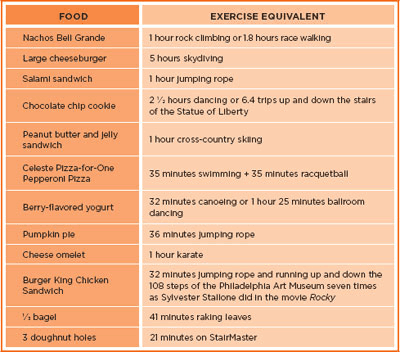CHAPTER 2
For Parents: A Warning and a Call to Action
There’s a good one-word reason for making the kind of healthy choices embodied in the Beat Diabetes Pyramid: kids.
Your kids, if you’re a parent. Kids in general, if you’re a concerned citizen and taxpayer worried about the rising tide of ill health in this country and the scarily rising cost of health care.
Check out the nearest playground. Those adorable little tykes on the swings and jungle gym are part of the first generation of Americans expected to have a shorter life span than that of their parents. Shorter and sicker.
Look closer. Some of those adorable little tykes are overweight. We used to think of it as charmingly pudgy baby fat. But today we know better. Childhood obesity has become an epidemic in this country, and it is an epidemic with alarming consequences. The extra pounds on little children put them at risk for:
- Heart disease
- Gallstones
- Liver disease
- Joint problems
- Asthma
- Digestive disorders
- Headaches
- Vision problems
That extra weight also increases their risk of diabetes. In fact, carrying even eleven extra pounds can double an individual’s risk of type 2 diabetes.
What is particularly frightening is that these health problems are showing up earlier and earlier in younger and younger children. The correlation—obesity and poor health—is now inescapable. Today, almost one in five American four-year-olds is obese. And type 2 diabetes is today being found frequently in children ages eleven and twelve and has been diagnosed in children as young as four.* The link could not be clearer.
Contracting diabetes before the age of forty shortens life span by some eleven to fourteen years, so when we hear that one-third of everyone born in the year 2005 will get diabetes at some point, it becomes clear why this generation has a shorter life expectancy than the previous generation. Moreover, in fifteen or twenty years, these kids will be having their own children, to whom they will pass on their unhealthy eating habits. How early will those kids get sick? And what will their life expectancy be?
Excess weight in young children is therefore not cute. With 90 percent of overweight kids having at least one avoidable risk factor for heart disease, an overweight or obese child is a time bomb waiting to go off. Young children who develop type 2 diabetes have more time to accumulate vascular and nerve damage; they are thus more likely to suffer severe and costly complications as they grow to maturity. They will pay a terrible toll in suffering and in limitations to their lives.
And the rest of us will pay a terrible toll in health care costs and in the cost of lost productivity of these individuals.
SODA AND THE METABOLIC SYNDROME
Researchers who tracked some nine thousand men and women over four years concluded that drinking at least one soda per day raised the likelihood of a diagnosis of metabolic syndrome by 44 percent.
THE PSYCHOLOGICAL TOLL
There’s another terrible price that children pay for being overweight: it is psychologically painful in a way that can scar an individual for life. Overweight kids often seem “different” or “other” to small children, and they may be made to feel that way: the last kid picked for the team, or the only one not invited to the sleepover. What’s more, children—even very young children—can be cruel, and a teasing nickname can slice a child like a knife through the heart.
Ostracized by contemporaries or self-isolated as a defense mechanism, overweight children early on develop a sense of inferiority and feelings of insecurity and low self-esteem, which can affect their adulthood in unhappy ways. In an era when body image seems shaped by impossible magazine fantasies and starved-looking Hollywood starlets on the red carpet, it’s little wonder that anorexia, bulimia and other eating disorders are on the rise among children as young as elementary school age, while there is also an increasing and intensifying surge in depression showing up in overweight and obese children. It is a heavy price for a little child to pay during the all-important developmental years.
How did it happen? How did our kids get to be this way—overweight, unhealthy and unhappy about it?
PARENTS ARE RESPONSIBLE
Again, there’s a simple one-word answer: us.
Sure, there are lots of outside influences on children—even on very young children—urging them to eat “fun” foods that are bad for them. But the dominant influence on kids, especially very young ones, remains their parents.
Children are not born with poor eating habits or the desire to eat unhealthy foods. They learn the eating habits that form their eating tastes from us, their parents. We’re the ones who buy the foods our kids eat. The meals we put on the table, the foods we order in or the restaurants we take our kids to establish patterns our kids learn to mimic. It’s how they acquire taste—which is a learned experience. That’s how and why we are ultimately the teachers of our children’s eating habits, and that makes us responsible for their eating future—and the diseases that come from it.
But lately, many parents seem to have begun to abdicate that responsibility. To be fair, the abdication hasn’t been by choice. When both husband and wife are working and the kids are busy with all sorts of after-school activities, it’s virtually impossible to plan family meals, much less to sit down together as a family to eat one. Result? Kids—and parents—rely more and more on fast food, which is high in carbohydrates, calories and fats. Americans eat 40 percent of their calories outside the home, and consumer spending on fast food has increased eighteen-fold since 1970. Waistlines have grown with the rise in fast food, and 70 percent of kids ages six to eight think fast food is healthier than homemade food. Sure they do: they have the former almost more frequently than the latter.
And the portions tend to be outsized—having nothing to do with what’s sufficient for normal growth, fitness and well-being. A recommended serving of meat, fish or poultry is 3 ounces; that is what is recommended for good health and nutrition by the U.S. Department of Agriculture, the Food and Drug Administration and the National Institutes of Health. The typical portion of meat, fish or poultry that Americans eat is about 8 ounces—nearly three times what is needed and recommended. Today’s typical pasta portion is 480 percent bigger than the government recommendation.
LARGE PACKAGE, SMALL SNACK
Studies show that small packages lead to bigger consumption of high-calorie snacks by the weight-conscious. One look at a large bag of, say, potato chips, and folks conscious of weight and body size may grab one or two, then quit—if they even open the package. But the 100-calorie snack packs are so readily seen as “diet aids” that the weight-conscious chow them down with impunity.
When you ordered a hamburger in 1957, you got a 1-ounce patty on a bun, and the whole thing contained 210 calories. When you order a hamburger today, you’re eating 6 ounces of food and taking in 618 calories. A side of fries was once 2.4 ounces, totaling 210 calories; today, you get 6.9 ounces and 610 calories.
School lunches aren’t much better; like most assembly-line eateries, they tend to offer lots of fried food, thus doubling down on the carbs, calories and fat content kids get in the fast-food places. And the beverage of choice at school as well as at home or in the restaurant tends to be soda—which is nutrition-free and typically loaded with calories. In 1950, American children drank three cups of milk to one soda; in the twenty-first century, that ratio is precisely reversed, with three sodas to a single cup of milk. Each of those sodas contains 150 calories, and all you need to gain 15 pounds a year is 150 calories—that is, a single soda—per day.
True, we can’t be responsible for what our children eat when they are not home. And let’s face it, we are up against a formidable opponent in the food industry, which spends tens of billions of dollars on advertising to young children, not to mention the indirect “advertising” on Web sites featuring licensed characters, games and the like. In fact, the average American child sees several thousand food advertisements on television each year. And despite the industry’s promises to the contrary, most of the advertising focuses on the least nutritious foods. As we learn from an October 2009 study by Yale University’s Rudd Center for Food Policy and Obesity, “the least healthy breakfast cereals are those most frequently and aggressively marketed directly to children as young as age two… The researchers’ evaluation of cereal marketing, the first such study of its kind, shows pervasive targeting of children across all media platforms and in stores.”* The reason is simple: get kids to like this stuff early, and they’ll be customers for life. So today’s kids are indeed growing up making unhealthy food choices. Did you know that 25 percent of the vegetables eaten in the United States today are french fries?
In addition, as every parent knows, kids are exercising less. By the age of seventeen, today’s child has spent 38 percent more time in front of the TV than in school. According to Time magazine, every hour of TV a kid averages per day raises his risk of obesity by some 6 percent. We can’t totally blame the kids: if they live in big cities, their parents tell them not to play outside because it’s too dangerous. If they live in the suburbs, there may not even be a sidewalk inviting them to walk to school. City or suburb, kids’ rooms are equipped with a computer, television, Xbox—you name it. Who wants the fresh air of the outdoors, who needs a leg-stretching run across a field, when you can do it all virtually or watch it from the comfort of your bed? No one, which is why most kids today spend from two to four hours in front of some sort of screen every day—and almost no time outside at all.
With too much fast food that is nutrition-free and a minefield for metabolic syndrome and not enough exercise, no wonder there is an epidemic of childhood obesity and a surge of such killer diseases as diabetes.
So yes, you’re up against a formidable obstacle in trying to get your kids to make healthy eating choices—a relentless barrage of images, endless chatter, peer pressure and the ever-present convenience factor.
But you’re not without resources. As parents, you are the first habit setters, and you can demonstrate the example both at home and in restaurants. You are also the first authority figures, with immense power to teach your children to make the right choices.
Bottom line? Just as we teach our children how not to behave—not to lie or cheat, not to be rude or unfriendly—so also can we teach them what not to eat. And just as we teach them to be honest, polite, considerate of others and responsible, so also can we give them the foundation of healthy eating that will enable them to grow up strong, fit and as protected against disease as possible.
GIVING YOUR KIDS A HEAD START ON HEALTHY EATING
The Beat Diabetes Pyramid is your family’s map to healthy eating. And the sooner you start the better. With type 2 diabetes showing up in eleven-year-olds, and with obesity plaguing four-year-olds, you cannot afford to wait.
If you are expecting a child or are the parents of a newborn, you can start providing your child the benefits—and pleasures—of varied, nutritious food as soon as the child is weaned and you have begun to introduce solid foods. If your child is beginning to show evidence of excess weight, you need to intervene now to retrain his or her way of eating.
ENVIRONMENT AFFECTS OBESITY
Who is most likely to be obese? Lower-income minorities and people in rural areas of the country. The Centers for Disease Control and Prevention track obesity by race, income and geography and find that African American and Hispanic children are more likely to be overweight than white American kids. More than twice as many kids living below the poverty line are overweight or obese than kids with family incomes above the line. And 16.5 percent of rural kids versus 14.4 percent of urban kids are obese.
Conclusion? Environment defines the choices available—including the eating choices. And adults create the environment for kids.
Whenever you begin, be sure to think of the changes you are making as being about health. If you talk to your child about the change, frame the discussion in just those terms—that the changes are about getting healthy. Talk about foods not as good or bad but as healthy or unhealthy. Don’t prohibit or restrict any foods; it will backfire. Instead of eliminating the food from your child’s eating pattern, you will imbue that food with special importance.
Perhaps the most important first step is for you yourself to model the eating behavior you want your child to assume. There is no more powerful lesson for your child than seeing you enjoy healthful foods and physical activity.
In fact, it is a good idea to make any change in eating habits a family affair. Involve everyone in creating a weekly healthy eating plan, and make meals regular collective events—no different meals or special foods for different family members. Make the outing to a fast-food restaurant a less and less frequent event—maybe cut back to once a week, then once a month and so on.
MODEL BEHAVIOR
As the song says, children are watching—and researchers at Dartmouth College agree. They took 120 kids ages two to six on a simulated shopping trip. When asked to “buy” foods at the make-believe grocery store stocked with toy foods, children whose parents customarily made healthier food purchases bought healthier foods.
Interview with Jonathan, 13 years old
When Jonathan came to me, he was 12 years old, 5’6” and weighed 228 pounds. Now Jonathan is 13, and after following a new diet for just 21 weeks he has brought his weight down to 186 pounds and significantly improved his health.
Dr. S: What is the main trigger that got you to start a diet?
Jonathan: I would get tired fast. I wanted to do all the things the boys in my class could do. I couldn’t exercise the same way as all of them. Now that I’ve lost weight I am starting on the basketball team. Probably the track team, too. And I’ll be able to run more.
Dr. S: What was the most difficult thing about starting a diet?
Jonathan: Not giving up. I didn’t give up. I used to eat a lot of fast food and starch, high-calorie foods. I don’t eat those foods that often anymore.
Dr. S: Do you miss them?
Jonathan: Sometimes. I have some replacements.
Dr. S: What are the replacements?
Jonathan: I used to have regular sausages—now I have Morningstar sausages. I found healthier snacks—like soy chips and low-calorie popsicles.
Dr. S: Did you ever feel uncomfortable about the fact that you were dieting while the other kids were eating high-calorie foods?
Jonathan: The other kids were eating pizza and other things in school, but it didn’t bother me that much because I knew one of these days I would have more energy and I’d be able to keep up with them.
Dr. S: Was it worth it?
Jonathan: Yes, I have more energy now and I can keep up with my friends.
Dr. S: What was the most difficult part of the diet?
Jonathan: Sticking to it in the “middle,” when I was partway through.
Dr. S: What advice might you give to a child who needs to go on a diet?
Jonathan: It might be difficult but it’s all worth it in the end. (Jonathan’s mother—Stephanie)
Dr. S: When Jonathan decided to start a diet, was it a conversation you had with him or did he come home and say something?
Stephanie: Jonathan asked me for help. He began to develop a complex, and when he asked me for help that’s when I began to do the research for a diet. At his school they had an obstacle course for exercising. He couldn’t do it. And he was embarrassed—when he did track he was the slowest. There were a couple of other kids on the team who tried to motivate him, but he knew he wasn’t part of it. He was discouraged. So when he came to me and asked me for help, it broke my heart.
Dr. S: How do you feel about it now?
Stephanie: I’m so proud of him. A lot of his friends encouraged him and told him he looked great. There were many times he could have gone off of the diet, but he didn’t. His attitude is better—now he wants to try on clothes. I’m really proud of him.
Dr. S: Was it difficult for you to make changes in your home?
Stephanie: I pretty much took control of his diet and everyone in the family supported him. Jonathan’s diet consisted mostly of fast-food restaurants—Wendy’s, McDonald’s—and he ate pretty much everything he wanted to eat. In the beginning it was very hard for me because I had to learn for myself, as well, to buy the proper foods. Shopping was so much different than in the past.
Dr. S: Do you feel responsible for the way he was eating before, when he was gaining the weight?
Stephanie: I feel responsible because he ate what was given to him. A lot of junk food, a lot of high-fat foods, foods that I was brought up on. I fed him what I was accustomed to. So this was a change for both of us. My family as well. We drink Crystal Light now and eat Morningstar sausages and other veggie products. There’s food in our house that we never had before. He taught himself as well as the family.
Dr. S: So Jonathan’s healthier and responsible for helping everyone in your house to eat healthy and lose weight?
Stephanie: I guess you can say that.
Dr. S: I think I will. What advice would you give to a child who’s overweight?
Stephanie: Basically, to seek help and to be a leader. I would tell a mother to go out and seek help not just for her child but for everyone in the family.
Dr. S: At what point would you tell a mother to intervene?
Stephanie: Right away—I’m giving advice already.
When you think about it, what you’re really trying to do is introduce new foods and/or flip the ratio of foods in a typical meal. That is, where you once served a large platter of meat and made vegetables a side dish, you now want to focus on the vegetables and relegate the meat to a marginal role in the meal. In introducing new foods, be aware that it may take a kid a dozen, fifteen, even eighteen tries before he or she is willing to embrace a new food. Our advice? Keep bringing the food back over and over again in different guises or versions and just put it on the table.
Suppose you offered green beans one day and they didn’t get a great reception. Bring them back the next day in a soup, the next day in a stew, the next day on a pizza, the next day cold in a salad. Keep at it, and don’t be discouraged. In time, your child will begin to taste the new food, then to accept it, then to like it.
SNACK ATTACK
Commercials do sell products, which is bad news when so many TV ads are for unhealthy foods. When kids between the ages of seven and eleven were shown a half-hour cartoon interspersed with ads for food, they ate 45 percent more than did kids of the same age who watched the same cartoon with non-food-related ads. Ditto for adults: they snacked more while watching TV shows with ads for junk food than those with ads promoting healthful foods or good nutrition.
Another trick: disguise the healthy food in or as something already well known. Our nutritionist has created recipes for pizza, a smoothie and cookies that are actually soy-based—and no one ever realizes it. Dr. Shapiro once served soy sausages to a bunch of New York City firemen, and they scarfed them down with gusto. Serve kids fruit on top of French toast or as a fruit pizza topping, or hide vegetables in a tart, and they’ll think these foods are fun to eat.
You’ll find plenty of recipes and food comparison demonstrations in these pages that will help you provide healthy foods to your children in varied versions or in clever disguises.
In addition, here are some essential dos and don’ts for building a strong foundation of healthy eating for your children.
Don’t:
- Make food a bargaining chip
- Judge your child’s eating either in words or body language
- Deprecate your own body image, weight or eating habits in front of your kids
- Pressure your kids—about their appearance, achievements, etc.—such that they flee from the pressure into food
- Isolate your overweight child from his or her siblings
- Force your child to eat when he or she claims satiety or lack of hunger
Do:
- Start early
- Make mealtime as much fun as possible
- Stock your larder with healthy snacks—after cleansing it of high-calorie foods
- Set limits on computer and television time for your kids; two to four hours a day is way too much for bodies that are developing and growing
- Serve small portions; if your child asks for a second helping, offer the lower-calorie foods first
Encourage exercise by taking a walk with your kids, playing catch with them, enrolling them in sports activities. Assign household chores that require movement: mowing the lawn, walking the dog, cycling to the store to pick up a loaf of bread.
Listen to your kids. If your child tells you about an incident of teasing or the like at school or makes negative comments about his or her body, seize the moment to have a discussion about healthy eating as a means to weight loss and strength.
Make sure you lavish the same love and attention on your overweight child as on all your children; they very much need to know they’re important to you.
Seek professional help and a thorough medical evaluation for your child if his or her excess weight has you concerned.
DOING IT RIGHT
And when you implement the changes that can save your child from a life of overweight and ill health, be sure to do it right. That means following the Beat Diabetes Pyramid as closely as possible, every day, at every meal.
As you go through the Pyramid chapter by chapter, you’ll see precisely why. You’ll learn about “light” foods that are anything but, about foods that claim to be “reduced fat” but still offer the wrong kind of fat, about “saboteur” foods that look and sound good for you—natural! wholesome!—but are actually loaded with calories and with substances that raise your risk of metabolic syndrome and your susceptibility to such killer diseases as diabetes.
The following meal plans show you what we mean. The daily meal plan on the left looks and sounds benign enough, but check out the totals compared to the far better meal plan—based on the Beat Diabetes Pyramid—on the right.
It isn’t even just a matter of the numbers; it’s also a question of the kinds of ingredients. Fats from milk, cheese, turkey, sour cream and sugar-free cookies are the “bad” kind of fat we discussed in Chapter 2. The low-fat granola is full of calories and added sugar. The 2 percent milk isn’t much lower in saturated fat than whole milk—not to mention the fact that dairy is not recommended for preventing or managing diabetes. Even the seven-grain bread, which sounds so nutritious, doesn’t necessarily contain the whole grain that is so important for nutrition. As to the sugar-free cookies, they are full of starch and fat.
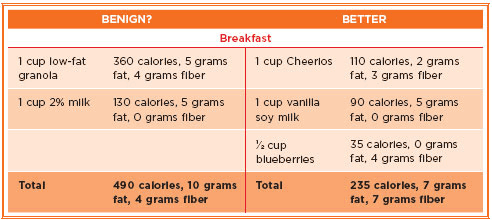
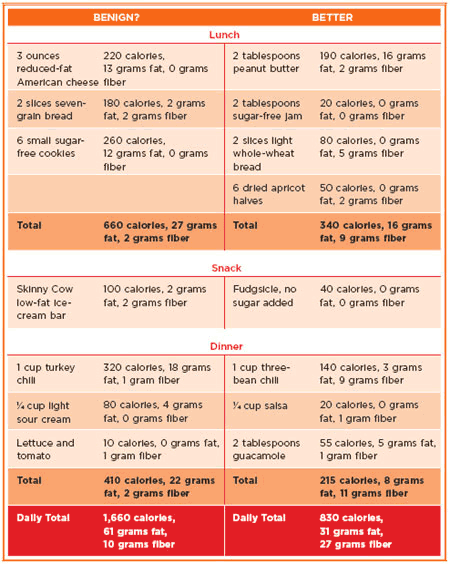
Now look how the Beat Diabetes Pyramid would do it, giving your child half the calories, half the fat and more than three times the fiber. This meal plan offers healthy fats from soy milk, peanut butter and guacamole. The classic Cheerios breakfast, as opposed to the granola on the left, includes a whole-grain cereal without added sugar. It’s served with soy milk that is low in saturated fat, cholesterol-free and, as you will read in the pages that follow, filled with benefits for weight loss, heart health and diabetes prevention. The sandwich bread is light bread, versus the seven-grain bread used on the left; it is lower in calories than regular bread and is an excellent source of fiber—the same amount of fiber (or more) than you find in regular whole-grain bread.
Get the picture? Then it’s time to start doing for yourself and your children what your mother told you time and time again—that is, to eat your vegetables.
FOOD FOR THOUGHT: IT’S YOUR CHOICE
Eating is a matter of choosing. Below are different food options with equal calories. Seeing the difference between food options can help you make healthy choices for a healthier you, and your children.
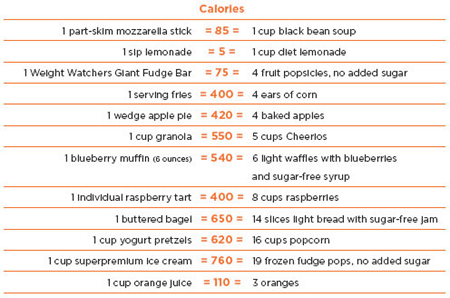
Want to show your kids how healthy eating can be fun, tasty and important? Sit down with them and go through the food demonstrations that follow. Every kid will find foods to love in these pages, so the demos are a great way to introduce your kids to new food choices—and to the idea that healthy eating is the most satisfying eating there is…
TOTING UP TACO BELL
Stopping by Taco Bell with the kids? Try steering them to the lower-calorie, better-for-you choices—a veggie fajita wrap or bean burrito, both of which offer the benefits of fiber—instead of the supersized nachos, loaded with saturated fat.
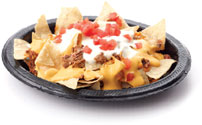
Nachos Bell Grande
740 calories
vs.
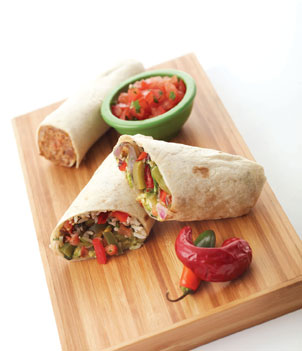
Veggie Fajita Wrap
420 calories
Bean Burrito
380 calories
CARROT CAKE COUNTDOWN
Just because it has carrots doesn’t necessarily mean it’s good for you. Take a look at what this slice of carrot cake contains in terms of fat, starch and sugar. That’s an 820-calorie danger signal for your health—not to mention the impact on your waistline!
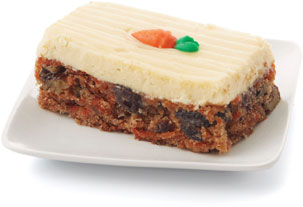
6 ounces carrot cake
820 calories

38 grams starch = 9 ½ teaspoons
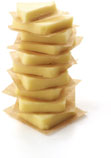
48 grams bad fat = 9 ½ pats butter

52 grams sugar = 13 teaspoons
LUNCH OUT
You’re out doing errands, the kids are with you and it’s lunchtime. To avoid the chaos and mayhem that hungry children can cause, you’ve got to feed them on the road. You can do so without sacrificing their health.
Drive right past that fast-food franchise that only offers burgers and head for one that offers more—or for the downtown coffee shop that makes sandwiches to go. Just look at the difference. The typical fast-food cheeseburger lunch, overstuffed with calories and saturated fat, is a ready-made package of future ill health. A more varied lunch—turkey sandwich with fruit and nuts—comes in at half that calorie count, while a tuna salad sandwich plus a banana and diet drink offers even less in the way of calories. Neither of these choices contains saturated fat, and both offer the health benefits of whole wheat and fruit.
You hate it when your kids get hungry and cranky, but you love them enough to make sure you satisfy their hunger in a healthy way.

|
Large cheeseburger |
530 calories | |
|
Large fries |
450 calories | |
|
Medium Sprite |
220 calories | |
|
TOTAL |
1,200 calories |
vs.
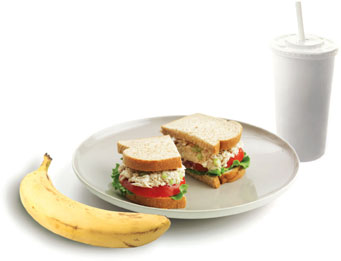
|
Tuna salad on whole wheat |
395 calories | |
|
Banana |
100 calories | |
|
Diet Sprite |
0 calories | |
|
TOTAL |
495 calories |
or
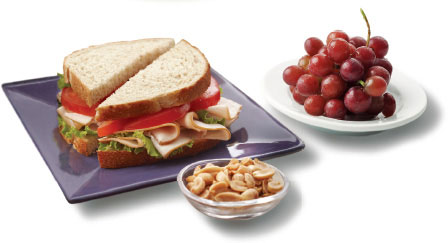
|
Turkey sandwich on |
440 calories | |
|
whole wheat with light mayo Grapes |
90 calories | |
|
Small package peanuts |
140 calories | |
|
TOTAL |
670 calories |
MEASURE FOR MEASURE
Here’s a difference in weight loss and diabetes-fighting power that’s pretty remarkable—especially if you love the taste of salami. Look at the salami sandwich on the left, and note how it measures up in terms of calories and fat. Both measures are pretty stunning. Now check out the sandwich’s fiber content: just 2 grams.
Contrast those measures with the measures of the veggie salami sandwich on the right plus a cup of tomato vegetable soup with its healthful supply of phytonutrients. At less than half the calories and only 4 percent of the fat, this lunch is already a help to your waistline and your fight against diabetes. Add in the 10 grams of weight-busting fiber and the soy protein of the veggie salami, and you have a diabetes fighter that really measures up.

|
2 slices rye bread |
160 calories |
0 grams fat |
2 grams fiber | |||
|
6 ounces salami |
540 calories |
50 grams fat |
0 grams fiber | |||
|
1 tablespoon mustard |
10 calories |
0 grams fat |
0 grams fiber | |||
|
TOTAL |
710 calories |
50 grams fat |
2 grams fiber |
vs.

|
2 slices light rye bread |
80 calories |
0 grams fat |
4 grams fiber | |||
|
4 ounces veggie salami |
140 calories |
1 gram fat |
2 grams fiber | |||
|
Lettuce/tomato |
10 calories |
0 grams fat |
2 grams fiber | |||
|
1 tablespoon mustard |
10 calories |
0 grams fat |
0 grams fiber | |||
|
1 cup tomato vegetable soup |
70 calories |
1 gram fat |
2 grams fiber | |||
|
TOTAL |
310 calories |
2 grams fat |
10 grams fiber |
A TREAT EVEN A MOTHER CAN LOVE
Sometimes kids just need a treat. (In fact, sometimes everyone needs a treat.) But you can help steer your kids to the kind of treat that has minimal adverse impact on their health. Instead of this chocolate chip cookie, for example, offer your child this frozen yogurt in a cone. Yes, it has some sugar and starch, but at about one-fifth the calories of the cookie and with no fat, it’s a treat for parent as well as child.
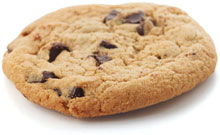
4-ounce chocolate chip cookie 640 calories, 40 grams fat
vs.

1 scoop frozen yogurt with cone 140 calories, 0 grams fat
PB&J
It’s everybody’s favorite, but if you’re weight-conscious, you can make it with a significant difference in calories that can achieve a significant difference for your waistline and your health. Use light bread, which is a great low-calorie source of fiber, and sugar-free jam and save 200 calories. You’ll still get all the taste you love—without the high calorie count that doesn’t love you.
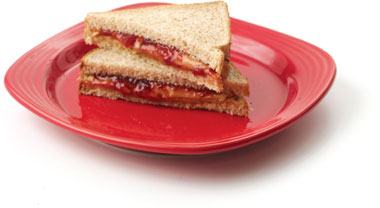
|
2 slices wheat bread |
180 calories | |
|
2 tablespoons peanut butter |
190 calories | |
|
2 tablespoons jam |
120 calories | |
|
TOTAL |
490 calories |
vs.
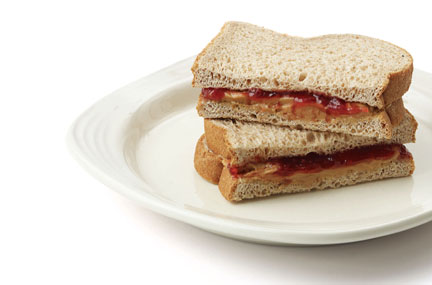
|
2 slices light wheat bread |
80 calories | |
|
2 tablespoons peanut butter |
190 calories | |
|
2 tablespoons sugar-free jam |
20 calories | |
|
TOTAL |
290 calories |
POLKA DOT PIZZA
1 large low-carb, high-fiber tortilla*
½ cup tomato-based pasta sauce or pizza sauce
½ cup zucchini slices; steamed
2 plum tomatoes, sliced
1 ounce veggie pepperoni slices (12-14 slices)
1 tablespoon chopped herbs—basil, oregano, Italian blend, etc.
Garlic powder
Salt
Pepper
Olive oil
1. Preheat oven to 500°F. Oil a baking sheet or spray with nonstick spray.
2. Place tortilla on baking sheet and spread sauce evenly over top, leaving a ½-inch border.
3. Arrange zucchini, tomato and pepperoni slices over sauce.
4. Sprinkle herbs on top. Sprinkle on garlic powder, salt and pepper to taste.
5. Drizzle with olive oil.
6. Bake 10 minutes, or until edges are crisp.

Pepperoni Pizza
Celeste Pizza-for-One
546 calories, 3 grams of fiber
30 grams of fat = 6 pats butter
vs.

Polka Dot Pizza
Makes 1 serving
230 calories
20 grams of fiber
7 grams of fat
= 1½ teaspoons oil
MAUVE MADNESS
¾ cup blueberries and/or blackberries
¾ cup soy milk
1 teaspoon vanilla or almond extract
3–4 packets Splenda
½ cup crushed ice or a few ice cubes
1. Process all ingredients except ice in a blender until smooth.
2. Add ice gradually, blending well after each addition.

8 ounce berry-flavored yogurt
240 calories, 0 grams of fiber
40 grams sugar
= 10 teaspoons sugar
vs.

Mauve Madness
Yield: 1 serving
120 calories
6 grams of fiber
0 grams added sugar
PUMPKIN PIE PUDDING
1 15-ounce can pumpkin
1 package sugar-free instant vanilla pudding
¾ cup water
1 tablespoon brandy or rum (optional)
1 teaspoon cinnamon
½ teaspoon pumpkin pie spice
¼ teaspoon salt
Mint leaves
Whipped topping for garnish if desired
1. Combine all ingredients except mint leaves and whipped topping in a mixing bowl and beat with an electric mixer for about 1 minute, or until smooth and well blended.
2. Spoon into dessert dishes and refrigerate at least 30 minutes before serving.
3. Garnish with mint leaves and whipped topping, if desired.
Yield: 4 servings

1 slice pumkin pie
390 calories, 17 grams of fat,
33 grams of sugar
= 5 ½ pats butter,
8 teaspoons sugar
vs.

Pumpkin Pie Pudding
65 calories,
5 grams fiber
0 grams fat,
0 grams sugar
VEGETABLE TART WITH POTATO CRUST
CRUST
1 pound frozen hash brown potatoes, thawed
3 scallions, chopped
¼ cup liquid egg substitute
1 teaspoon finely chopped fresh thyme
¼ teaspoon salt
FILLING
1 small zucchini, chopped
1 garlic clove, minced
2 slices veggie Canadian bacon or 2 veggie bacon strips, chopped
2 cups packed coarsely chopped spinach leaves
1 small tomato, cored and chopped
¼ teaspoon salt
¼ teaspoon freshly ground black pepper
¾ cup liquid egg substitute
¼ cup (1 ounce) shredded fat-free cheddar cheese or dairy-free alternative
Preheat the oven to 350°F. Coat a 9-inch pie plate or tart pan with removable bottom with cooking spray.
1. In a medium bowl, combine the potatoes, scallions, egg substitute, thyme and salt. Press the mixture onto the bottom and up the side of the prepared pan. Bake for 30 minutes, or until firm to the touch. Cool on a rack.
2. Meanwhile, heat a medium nonstick skillet coated with cooking spray over medium heat. Add the zucchini and garlic and cook, stirring, for 2 minutes, or until tender. Add the Canadian bacon, spinach, tomato, salt and pepper and cook, stirring frequently, for 5 minutes, or until the spinach is wilted and the liquid has evaporated. Remove from the heat and cool. Stir in the egg substitute.
3. Pour the vegetable mixture into the crust. Sprinkle with the cheese. Bake for 25 minutes, or until the filling is set and the crust is golden brown.
Yield: 6 servings
Per serving: 140 calories, 2 grams fat

1 cheese omelet
490 calories, 38 grams fat
vs.
Tart for a Start
It would take more than three servings of tart to equal the calorie count of this single cheese omelet. But calories are only part of the story. The omelet, made with two eggs and cheddar cheese and fried in butter, has five times more fat than the tart. What’s more, the omelet contains the “bad” saturated fats that raise levels of LDL cholesterol and may increase the risk of heart disease. Start your day instead with nutrient-rich, fiber-filled vegetables in a tasty tart.

3 ½ servings
Vegetable Tart with Potato Crust
490 calories,
7 grams fat
BEAN BURGERS WITH LIME-SCALLION YOGURT SAUCE
½ cup low-fat plain yogurt or soy alternative
1 scallion, white and green parts, finely chopped
1 teaspoon lime juice
1 15 ½-ounce can black beans, rinsed and drained
1 large egg white or ¼ cup liquid egg substitute
¼ cup chopped fresh cilantro
½ red onion, coarsely grated
1 jalapeño, seeded and finely chopped (wear plastic gloves when handling)
1 tablespoon unseasoned whole-wheat bread crumbs
½ teaspoon cumin
¼ teaspoon garlic salt
4 whole-wheat pitas or lavash breads, warmed
4 large leaves romaine lettuce, shredded
4 thick slices tomato
1. In a small bowl, combine the yogurt, scallion and lime juice. Chill the sauce until ready to serve.
2. In a large bowl, mash the beans with the egg white or egg substitute until only slightly lumpy. Stir in the cilantro, onion, jalapeño, bread crumbs, cumin and garlic salt until well combined. With floured hands, shape the bean mixture into 4 burgers.
3. Heat a large nonstick skillet coated with cooking spray over medium heat. Add the burgers and cook for 4 minutes per side, or until lightly browned and firm.
4. Place the burgers in the pitas or lavash. Top each with the sauce, lettuce and tomato.
Yield: 4 burgers
Per burger: 305 calories, 3 grams fat

Burger King
chicken sandwich
660 calories, 39 grams fat
Fast-Food Object Lesson
Here’s proof, if more were needed, that mass-producing food for speedy delivery and low cost carries a high price tag in calories and saturated fat. And while some fast-food places are opting for low-calorie options, chicken does not necessarily qualify. Instead, go for this quick-to-make bean burger. Flavored with a zesty salsa and wrapped in pita or lavash bread, it’s a quick and healthy treat.
vs.

Bean Burger with Lime-Scallion Yogurt Sauce
305 calories
3 grams fat
FRUIT PIZZA
1 cup light vanilla yogurt or soy alternative
4 light English muffins, split
1 peach
½ cup raspberries
1 teaspoon Splenda
¼ teaspoon cinnamon
1. Line a sieve with 2 pieces of paper towel. Place the sieve over a bowl. Spoon the yogurt into the sieve. Cover with plastic wrap and place in the refrigerator overnight.
2. Preheat the broiler. Cut a peach into segments. Place the English muffin halves on a broiler pan rack. Coat lightly with cooking spray. Sprinkle each muffin half with some of the Splenda and cinnamon. Broil for 1-2 minutes, or until golden brown. Remove the muffin halves. Top with the yogurt and fruit.
Yield: 4 servings (1 whole muffin per serving)
Per serving: 160 calories, 1 gram fat

1/3 6-ounce bagel
160 calories, 1 gram fat
=
Pizza for Breakfast
Is there a kid who doesn’t love pizza? Give yours a change-of-pace treat and concoct this high-nutrition Fruit Pizza for breakfast. It starts with a light English muffin, adds fresh fruit and berries, yogurt as the pizza “cheese,” even some cinnamon flavor. A great way to incorporate fruit into your child’s diet, a delicious start to the day and a healthful and satisfying alternative to the nutrition-free calories of this piece of bagel.

1 serving Fruit Pizza
160 calories
1 gram fat
STUFFED FRENCH TOAST
1 cup liquid egg substitute
½ teaspoon grated orange peel
8 slices light bread, any flavor
½ cup light cream cheese or nondairy alternative
½ cup sugar-free syrup
½ cup blueberries and/or strawberries
Preheat the oven to 450°F. Coat a baking sheet with cooking spray.
1. In a pie plate, combine the egg substitute and orange peel. Dip each slice of bread into the egg mixture, turning to coat, until each slice has soaked up some batter. Place on the prepared baking sheet. Bake for 12 minutes, turning once, or until golden brown.
2. Spread 2 tablespoons cream cheese on each of 4 slices of the bread. Arrange the strawberries on top. Cover with the remaining bread slices to make 4 sandwiches.
3. To serve, cut each sandwich diagonally in half. Evenly divide the syrup over each sandwich and sprinkle with berries.
Yield: 4 servings
Per serving: 210 calories, 2 grams fat

3 doughnut holes
210 calories, 9 grams fat
=

1 serving Stuffed
French Toast
210 calories
2 grams fat
BEAT DIABETES PEANUT BUTTER “COOKIES”
2 scoops unsweetened soy protein powder (about 2/3 cup)*
2/3 cup granulated Splenda
6 tablespoons creamy peanut butter
¼ – 1/3 cup chopped peanuts
6 tablespoons water
1 teaspoon vanilla extract
¼ teaspoons salt (if using unsalted peanut butter, add an additional pinch of salt)
Preheat oven to 375°F. Lightly oil a baking sheet, or coat with nonstick spray.
1. In a large bowl, mix all ingredients together until a dough is formed. If mixture is too dry, add an additional 1 tablespoon water.
2. Roll tablespoons of dough into 1-inch balls and place on prepared baking sheet; flatten balls into approximately 2-inch rounds.
3. Bake 8 minutes, or until bottoms are lightly browned. Cool before removing from pan.
Yield: about 12 cookies
Approx. 78 calories per cookie
BEAT DIABETES ALMOND “COOKIES”
Simply follow the above recipe substituting almond butter and chopped almonds for the peanut butter and chopped peanuts, and almond extract for the vanilla extract.
ATTENTION COOKIE DOUGH LOVERS: this dough is safe to eat—feel free to sneak a few mouthfuls!
These cookies are a good source of soy protein and diabetes-friendly monounsaturated fat.

BITE OR BURN
Eating to beat diabetes doesn’t mean you can’t eat that fast food you’ve been craving. Exercise also plays an integral role in keeping the disease, and your waistline, at bay. The figures below illustrate just how much exercise it takes to burn off the calories of some of the non-pyramid foods in this chapter.
